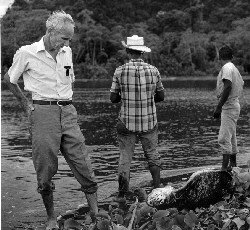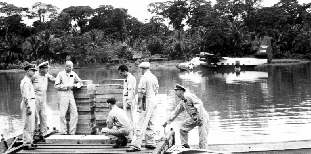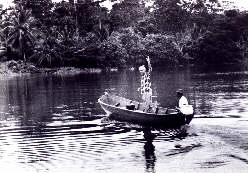The history of the Sea Turtle Conservancy (STC) is forever intertwined with the life and accomplishments of Dr. Archie Carr. He was truly a remarkable man — an exquisite writer, an inspiring teacher and a naturalist the likes of which may never be seen again. Dr. Carr was the founding scientific director of STC, a role he filled until his death in 1987. Through his research, teaching and writing, Dr. Carr is responsible for accumulating and distributing much of what is known about the biology and life cycle of sea turtles. He is credited by many for bringing the first international attention to the plight of marine turtles. The brief biography presented below was written shortly after Dr. Carr’s death by STC Board member Dr. David Ehrenfeld. It was first published in the August 1987 issue of Conservation Biology, the Journal of the Society for Conservation Biology.
Archie Carr, noble spirit and greatest conservation biologist of these troubled times, died at his home on Wewa Pond near the town of Micanopy, Florida, on May 21, 1987. At the time of his death, he was the world’s leading authority on sea turtles, a tropical field ecologist of exceptional skill and experience, a brilliant writer for audiences of both scientific and popular literature, a distinguished taxonomist and evolutionary biologist, and an internationally acclaimed advocate of conservation.

Archie F. Carr 1909-1987
Archie Fairly Carr, Jr., was born on June 16, 1909, in Mobile Alabama, where his father was a Presbyterian minister and his mother a piano teacher. His keen ear for language and music developed early: as a child he learned Gullah, the lyrical dialect of coastal, southern blacks; this linguistic ability few other whites shared. In later years he developed his language skills by collecting dialects from the Caribbean area and east Africa. He would treat his students and many friends to anecdotes from the Mosquito coast or Grenada or Grand Cayman, told in the way they had been told to him. He prided himself on his Spanish, learned from a Cuban roommate in college and perfected during his years of living in Honduras and Costa Rica. After giving a series of Spanish radio broadcasts in Costa Rica on the subject of evolution, he was told by one university professor,”You have mastered our language.”
Above all, he loved the sounds and rhythms of English. For those of us gathered in the Casa Verde after an evening walking the turtle beach, hearing Archie recite from memory Jabberwocky or a comic poem by P.G. Wodehouse with the accompaniment of the night sounds of the jungle and the Caribbean surf was an experience of a lifetime.
And he was equally adept with the written word. His chapter “The Black Beach” in The Windward Road, published by Knopf in 1956, won an O. Henry Award (Best Short Stories of 1956). He also won the John Burroughs Medal of the American Museum of Natural History for nature writing. His Handbook of Turtles: The Turtles of The United States, Canada, and Baja California, published in 1952 by Cornell University Press and still in print, was a model of authoritative yet lively scientific writing, winning Daniel Giraud Elliott Medal of the National Academy of Sciences. Archie Carr wrote 10 books and more than 120 scientific papers and magazine articles during his career of more than half a century.
It was his father who instilled in Archie Carr his love of animate and inanimate nature, and the backyard of his home in Savannah, Georgia, where he grew up was filled with cages of snakes, lizards, and turtles. He was an avid hunter, but lost his taste for it in Africa, a change that he described in his book Ulendo: Travels of a Naturalist in and out of Africa, published by Knopf in 1964.
His 1937 doctorate, the first granted in zoology by the University of Florida, was under the supervision of professor J. Speed Rogers, a limnologist. The entomologist Theodore Hubbell also influenced him strongly, as did the great animal ecologist W. C. Allee, who taught him the importance of ecological organization. Allee, who had been paralyzed by an accident, was carried around the Florida countryside in a wheelchair by the zoology graduate students.
Although he learned ecology early, his first professional accomplishments were in taxonomy and evolutionary biology. From 1937 to 1943, Archie Carr spent his summers with Thomas Barbour, at Harvard’s Museum of Comparative Zoology. It was Barbour who first expanded his horizons and gave him confidence in his own rapidly maturing intellectual powers. Barbour was the most important single person in Archie Carr’s formative years as a biologist. They were very close, and Barbour often came to Gainesville, Florida, to visit the Carrs. Barbour, a man of boundless enthusiasm for life, taught by example that it was proper to glory in the natural world – to savor and enjoy it. Margie Carr still remembers seeing the elderly Barbour outside in the Florida dusk with tears streaming down his cheeks because he could no longer hear the high notes of the chorusing cricket and tree frogs.
At the MCZ, Archie Carr also cultivated his appreciation for exotic foods, at the sumptuous meals that “T.B.” served. During these years, he co-authored with Barbour Antillean Terrapins, a monograph describing new turtles from Cuba, Haiti, and the Bahamas. The Windward Road was dedicated to Barbour’s memory.
From 1945 to 1949, Archie Carr was on leave from the University of Florida, teaching biology in Spanish at Wilson Popenoe’s Escuela Agricola Panamericana in Honduras. This was when he first became familiar with the forests and peoples of Central America (described in his book, High Jungles and Low, University of Florida Press, 1953). Ten years later he added to his Central American experience with a two-year stay at the University of Costa Rica.
Throughout his life Archie Carr traveled widely as a research and consulting biologist. During the 1960s, this was facilitated by the Military Air Transport Service privileges that were apart of his Office of Naval Research grant to study sea turtle migration and navigation. He could travel free to any place in the world visited by U.S. military aircraft. His sea turtle studies took him to every part of the Gulf of Mexico, Caribbean, northeastern South America, and Pacific Central America. He also visited and worked in east Africa, New Caledonia, Papua New Guinea, Australia, and other places. Some of his research was done at sea; in 1978, he took part in the Green Turtle Expedition of the R.V. Alpha Helix in the waters off Costa Rica and Nicaragua. His knowledge of world ecosystems was legendary – it is said that when Time-Life Books was starting its meticulously researched series of natural history books, the editors offered him his choice of continents to write about. He chose Africa.
A fine teacher in the classroom Archie Carr kept his graduate course on community ecology even after he had been appointed Graduate Research Professor, the University of Florida’smost distinguished academic position, and no longer was required to teach. But the high point of the course was always the field trips. Lacking the formality of the great Linnaeus, who marched his deciples into the field to sound off kettle drums and French horns, Professor Carr nevertheless managed to make his field trips memorable. Bringing to bear his great familiarity with zoology, botany, soils, geology, history, and cultural anthropology, he sketched an exceptionally vivid picture of the landscapes he visited and showed his students the need to weave together all of these disciplines to begin to understand the subject matter of ecology. And if he could catch a poisonous cottonmouth moccasin or rattlesnake to wave about among his more reticent students, his day was complete.
One of the unforgettable characteristics of this most charismatic of modern biologists was his humor. Everyone who knew Archie Carr has funny stories to tell about him. There was the party in Honduras that he attended dressed as a witch and carrying a live vulture. Or the time he snatched up and ate one of the type specimens of a newly caught species of fish from the Rio Tortuguero, just to see (and describe with glee for years afterward) the outraged reaction of its horrified discoverer. I particularly remember a tension-filled IUCN sea turtle meeting in Miami. A number of us had gathered to talk on the sidewalk outside the motel in the warm evening air, when we were interrupted by a shambling and ragged hag who pushed by us, muttering and cursing. Only after she had passed did we realize that the old crone was Archie.
I believe that one of the critical reasons for Archie Carr’s remarkable productivity was his ability to shun academic politics, red tape, and administrative folderol. While he would express sympathy with worthy causes, he could not be drawn in or embroiled. To his students, who loved to watch his incredible techniques for escaping tactfully from bores, bureaucrats, egomaniacs, and enthusiasts, he seemed to be able to vanish through solid walls. Another reason for his productivity was his intellectual focus: he worked almost entirely on turtles, kept his objectives always in mind, and was never sidetracked, even during his final illness.

Archie Carr’s family life was as rich and full as his professional career, and was thoroughly intertwined with it. He married Marjorie Harris in 1937; she is a biologist and distinguished conservationist in her own right. They had five children, one daughter who is a professional actress, and four sons who have pursued careers in conservation biology.
It seems to me that three things made Archie Carr become a conservationist. His vast knowledge of the natural history of Florida (reminiscent of Gilbert White at Selborne) was part of his superb sense of place and gave him an acute awareness of destructive change. His visits to Africa ended his comforting fantasies of eternal wilderness in faraway places. And his work with sea turtles taught him to see the world – as few people have – through the eyes of other species.
Whatever the reasons why he became a conservationist, he was highly successful. Tortuguero National Park in Costa Rica is a monument to his efforts over 30 years, as is part of the conservation consciousness of that superb country. The Sea Turtle Conservancy (created by newspaperman Joshua Powers as “The Brotherhood of the Green Turtle”) was inspired by The Windward Road and has become an international force for the preservation of sea turtles. The STC was first funded primarily by the late John H. (Ben) Phipps to help support Archie Carr’s research at Tortuguero. For several decades, until the death of Ben Phipps, the philanthropist and the scientist maintained a relationship of close friendship and absolute trust.
For 20 years Archie Carr was chairman of the Marine Turtle Specialist Group of IUCN’s Survival Service Commission, forging and directing the international movement for the conservation of sea turtles. During his tenure as chairman he was not afraid to take controversial stands. He consistently fought against the commercial “ranching” of sea turtles and sale of their products, a position that was supported by U.S. regulations and by CITES convention. He also opposed the removal of sea turtle species from the IUCN endangered or threatened lists merely because particular populations appeared to be doing well.

Navy Fliers and Grumman Albatross used to deliver boxes of hatchling sea turtles to countries in the Caribbean. 1967
In the 1960s Archie Carr started and directed the U.S. Navy’s “Operation Green Turtle,” a project to distribute green turtle (Chelonia mydas) eggs and hatchlings from Tortuguero to erstwhile nesting beaches around the Caribbean and Gulf of Mexico. Although the long-term effects of Operation Green Turtle are unclear, conservation efforts at Tortuguero itself have produced the beginnings of a dramatic recovery of its nesting green turtle population during the 1980s.
Besides his conservation work on behalf of sea turtles, Archie Carr also supported his wife’s effective campaigns for conservation in Florida, and in the past few years devoted increasing time to the problem of marine pollution by plastics and petroleum. He won numerous awards and honors for his conservation work. These include the World Wildlife Fund’s Gold Medal, the Smithsonian Institution’s Edward W. Browning Award, the New York Zoological Society’s Gold Medal, and the Hal Borland Award of the National Audubon Society. He was also appointed, by Prince Bernhard of the Netherlands, an officer of the Order of the Golden Ark.
Above all, Archie Carr was a great biologist. His early descriptive studies of turtles set the standard of quality in the field of natural history. Later on, as he focused on sea turtles, he moved toward ecology and behavior, although his work always retained a taxonomic and evolutionary perspective. For decades the National Science Foundation (and the Sea Turtle Conservancy and the Office of Naval Research) supported his research at Tortuguero, enabling him to mount one of the longest lasting and most intensive studies of an animal population that has ever been done. To date, more than 35,000 adult female green turtles have been tagged at the research station at Tortuguero. From this effort have come papers by Archie Carr, his students, and other investigators on orientation, migration, nesting behavior, nest physiology, sensory physiology, nutrition, demography, and other subjects. Almost all of the studies have significance for conservation — Archie Carr was a conservation biologist long before the field was recognized.

Archie Carr going places, Tortuguero. 1967
Although his work had a consistent goal and focus, he never stagnated. Perhaps this was because he had set himself such an immense task, the elucidation of the life histories of sea turtles. He accomplished much to shed light on these elusive creatures, but his own discoveries kept expanding the work that remained to be done. Characteristically, in one of his last papers, published in this issue of Conservation Biology, he charts new territory, not only for sea turtle research but for ecology and conservation in general. An unexpected out growth of his 30-year investigation of marine turtles’ complex life cycles, he describes a relatively unknown ecosystem of global importance, the Langmuir bands, or drift lines, of the open ocean, and calls attention to the special vulnerability of these convergence zones to marine pollution. I spoke with him about this work in March, in his living room, under the elegant Audubon print of Carolina parakeets, as we looked across the terrace to the sinkhole lake below. He knew then that he would not live to study these bands, yet his view continued to sweep out beyond present horizons to the needs and opportunities of the next generation of researchers. It was fitting that only a week before he died, Archie Carr was presented with the Ecological Society of America’s Eminent Ecologist Award.
The world that Archie Carr explored and wrote about is changed. Many of the things he knew are gone or passing. Some of us who continue his work will pause at times to read a passage from his writings that describes, with the full intimacy of love and genius, a landscape or a part of wild nature or human culture that has vanished beyond recovery. To experience the world through his words is also to understand why his like cannot pass this way again.
Yet the sea turtles remain, thanks in great measure to the long labors and measured wisdom of Archie Carr. So do two generations of conservationists whom he inspired and trained. They are all witness to the fact that the labor cannot be halted, however briefly, and that it has a purpose which can sometimes be fulfilled.
Perhaps Archie Carr was right, and in much of the world, as in the Florida he knew so well, the destruction that “is going on now is just a lot of little clean-up operations, little scratchings-out of small tag-ends and patches of the past overlooked in the first waves of ruin.” But if so, he lived fully and still found much to celebrate. He was one of the last great minstrels of wilderness, singing a song of joy mixed with abiding melancholy, a song that saddened his listeners even as it gave them heart to fight, as he did, against the unthinkable outcome.
His own words say it best. Here is a selection from the last chapter of Ulendo:
“At first it was hardly more than a feeling in the ground, from out in the night somewhere. Then there was a bass cough, and crumping sobs gathered and went rolling about the dark, one by one, like barrels tumbling. It was the lion song, and I sat quiet to learn it, as you learn the trill of a tree toad, or how an alligator goes. And though there may have been little real song in the sound, it came in strong and lonely through the whisper of the mist; and to me, at the time, it seemed to tell of an age being lost forever.”
By Dr. David Ehrenfeld